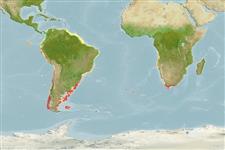Bivalvia |
Myida |
Teredinidae
Environment: milieu / climate zone / गहराई सीमा / distribution range
पारिस्थितिकी
; गहराई सीमा 0 - 55 m (संदर्भ 87801). Subtropical; 11°N - 53°S (संदर्भ 83435)
Southern Atlantic and Southeast Pacific.
Length at first maturity / आकार / Weight / Age
परिपक्व अवधि: Lm ? range ? - ? cm
Found from intertidal areas to a depth of 55 meters, on wood, in submerged tree trunks, pilings or even boring into ships. It has a free-living larva (Ref. 87801).
Life cycle and mating behavior
परिपक्व अवधि | पुनरुत्पत्ति | मछलीऔ का अंडे देना | Eggs | Fecundity | Larvae
Members of the class Bivalvia are mostly gonochoric, some are protandric hermaphrodites. Life cycle: Embryos develop into free-swimming trocophore larvae, succeeded by the bivalve veliger, resembling a miniature clam.
Bernard, F.R., S.M. McKinnell and G.S. Jamieson 1991 Distribution and zoogeography of the Bivalvia of the Eastern Pacific Ocean. Canadian Special Publication of Fisheries and Aquatic Sciences 112:60 pp. (संदर्भ 91446)
IUCN Red List Status
(संदर्भ 130435: Version 2025-1)
CITES status (संदर्भ 108899)
Not Evaluated
CMS (संदर्भ 116361)
Not Evaluated
Threat to humans
Human uses
| FishSource |
साधन
अधिक जानकारी
Trophic EcologyFood items (preys)
संघटक आहार
आहार खपत
परभक्षी
Population dynamicsबाढ़
Max. ages / sizes
Length-weight rel.
Length-length rel.
Length-frequencies
Mass conversion
बहुतायत
Life cycleपुनरुत्पत्तिपरिपक्व अवधिFecundityमछलीऔ का अंडे देनाEggsEgg developmentLarvae PhysiologyOxygen consumption
Human RelatedStamps, coins, misc.
इंटरनेट स्रोत
Estimates based on models
Preferred temperature
(Ref.
115969): 10 - 22.7, mean 15.2 (based on 134 cells).
Price category
Unknown.
